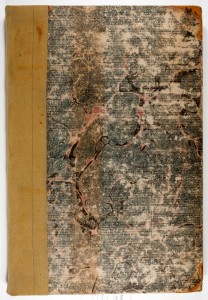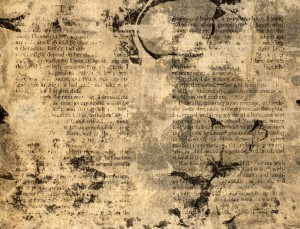Past is Present‘s series of posts on the upcoming Adopt-a-Book event will resume tomorrow. For today, please enjoy this story of (un)covered literary history.
Ungracious then as the task may be, I shall recall to view those scandalous stages of my life…

So say the marbled boards** (see further information below) covering AAS’s copy of Jonas Hanway’s Advice from Farmer Trueman to His Daughter Mary. The text inside is a series of discourses in which Farmer Trueman warns his daughter of the perils awaiting a country girl upon moving to the city: if a “silly proud girl,” then she may be “seized by the cold hand of poverty” and “to relieve her wants…[become] a prostitute.” Just such a tale seems to peek out of the book’s marbled boards, perhaps to accentuate Farmer Trueman’s virtuous message in one odd and unintended pulp story.
Or perhaps not. The sheets covering the boards of this 1810 Boston edition are actually unbound, unused copies of John Cleland’s quite vicious Memoirs of a Woman of Pleasure (popularly known as Fanny Hill). Marcus McCorison, AAS President Emeritus, bibliographer, and author of an essay on early American printing of Fanny Hill, has pointed to the “curious juxtaposition of pious works” bound with such risqué words. Perhaps an impertinent binder, with a supply of marbled Fanny Hill sheets at his side and a Hanway book to bind, covered this copy of Advice From Farmer Trueman. The binder may never have thought that the marbling would wear away, expose Cleland’s words, and reveal the binder to be quite the ironist.

This anonymous binder was not unique in presenting such “curious juxtapopsitions.” In 1814, AAS founder Isaiah Thomas bound many of his newspapers in pages from Fanny Hill, as McCorison points out. Thomas marbled any paper at hand, using sheets of everything from the Psalms to Francis Blagdon’s History of Christian Martyrdom to Fanny Hill to cover his newspapers. So when readers request AAS’s early American newspapers, they may be confronted with quite a surprising array of “curious juxtapositions.”
At times our books relay information, ideas, and even wisdom to us only with repeated readings and incessant handling. Fanny Hill had been obscured by censors (and marbled paper) for years. It was only on this date (March 21) in 1966, over 200 years after its first printing and over 150 years after its first American printing, that the U.S. Supreme Court finally declared that Cleland’s novel was not obscene. Readers, critics, and time had their way with the censors and with the paper. Sometimes our books, as well as their secrets between and even under their covers, have a way of knowing (at least some) things before we do.
Further Information:

** “The boards” are the covers of a hard bound book, which were usually covered with scrap paper. Often, as in the examples shown here, that paper was decorated with a multi-colored, swirled design or pattern called marbling. Many pre-1850 books were issued by the publishers bound in paper covered boards, allowing for an inexpensive binding which could later be replaced with leather by a hand book binder. Read more at The Antiquarian Booksellers Association of America’s Glossary of Book Terms.
McCorison, Marcus A. “Memoirs of a Woman of Pleasure or Fanny Hill in New England,” American Book Collector 3 (1980): 29-30.
McCorison, Marcus A. Risque Literature Published in America Before 1877. (Available online)
